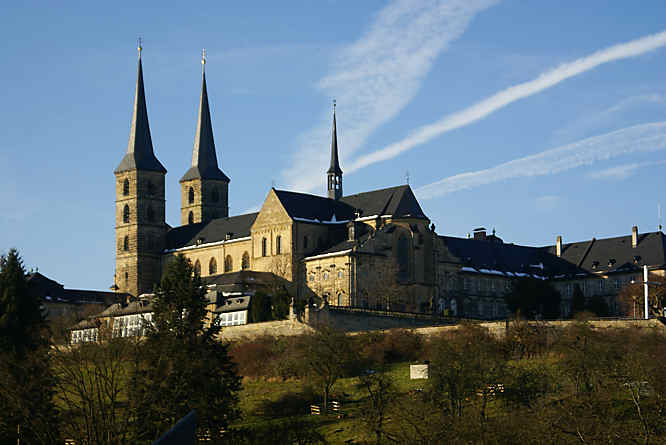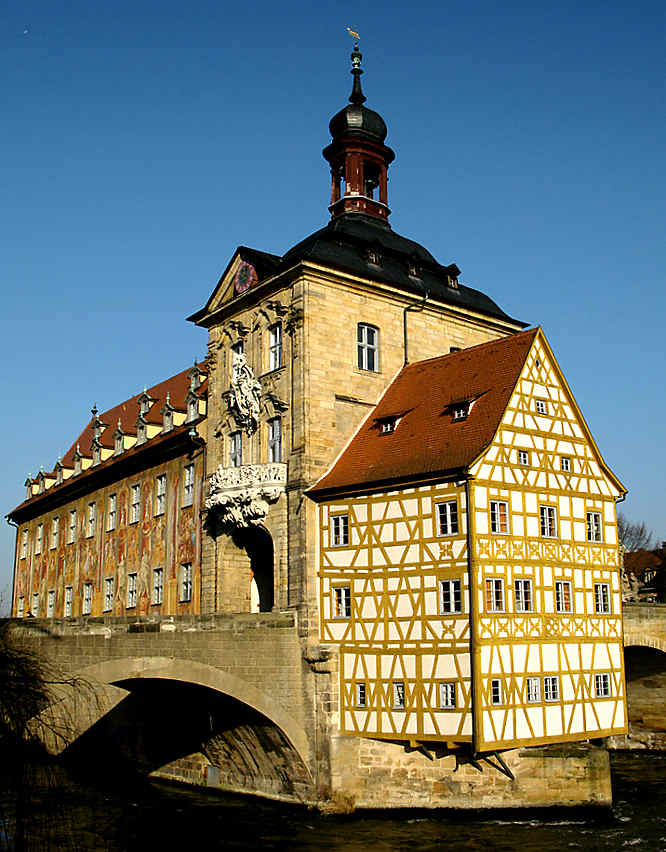Bamberg German Christmas Market
The German word 'berg' means castle or fortified town. The central part of the city is on a long large island. On the west bank is the area called Seven Hills district or castle town 'bergstadt'. It is very hilly and each one is dominated by a castle, church, palace or monastery.

It also contains most of the city's picturesque old buildings. There are many tight and narrow streets, with many beautiful old buildings, tucked haphazardly around the seven hills. They are crammed into a tiny area. There are plenty of little alleyways to explore. Each recalls a different time in history. The variance in architecture styles and hilly elevation means you will be endlessly snapping photographs.
Alte Rathaus (The Old Town Hall)
What can I say? This building looks better in real life than it does in its photograph. The Alte Rathaus sits in the middle of the River Regnitz. The 15th century half-timbered building falls all the way down the side of the bridge almost into the river itself. Hovering over the two bridges is the newer part of the Town hall, built in the 18th century in an amazingly over the top garish Baroque and Rococo style.

The colourful vivid frescoes on the sides of the building are just fantastic, and make this one of the most unusual and most picturesque town halls in all of Germany. This sight alone makes Bamberg unmissable. According to the legend, Bamberg's bishop did not want to give a single centimetre of land to the citizens. This is why the citizens of Bamberg rammed piles in the River Regnitz for their Town Hall and created an artificial island at the centre of the Regnitz.
The location marks the border between the clerical city on the hills and the merchants' island city and has therefore to be considered as a proud demonstration of civil striving for power. The best location for taking a photograph of the Alte Rathaus just south of it down river on the next bridge. Go in the morning as there is too much shadow in the afternoon
Bamberg Old Town Christmas Market
I was a little disappointed by the old town on the Inselstadt or island town. I was expecting little streets full of charming half timbered buildings. What I found was large modern streets packed with modern shops that you can find in any major European city. If you like shopping you will love the place but if you came for a glimpse of old Germanic culture you will be disappointed with this part of Bamberg. It is hard to visualise how this huge artificial island, in the centre of the River Regnitz, was created by driving wooden piles into the river bed. It's construction is very similar to how Venice was built out of its saltwater lagoon.
The bamberg Xmas market starts at the bottom of a wide street called Gruner Market. It used to be the site of the vegetable and flower market or Green Market. Christmas stalls line each side of the road all the way up to the main Christmas market in Maximilian Platz. Bamberg's Christmas market is a good market but the City has not taken care to make the stalls attractive. The roves are covered in scruffy industrial white tarpaulin to keep them water proof. They have crammed the rows of stalls far too close together so walking up and down the stalls is not a pleasant experience, as you have to fight your way through the crowds. The quality of the craft products on sale is high but shopping in the Nuremberg, and Coburg Christmas Markets is a much more enjoyable.
Little Venice
Just south of the markusbrucke bridge on the east bank is a row of former fishermen houses. The area is called "Little Venice". These small medieval half-timbered houses with balconies and tiny gardens, in which there are moorings for boats, line up along the bank of the River Regnitz. There is a foot path on the opposite bank that gives you a good view of these charming buildings. Look out for the restored crane that was used to unload the boats.
Travel books

